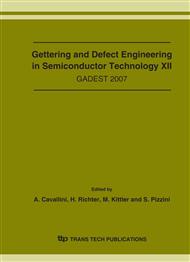[1]
T. Abe and H. Takeno: Mater. Res. Soc. Symp. Proc. Vol. 263 (1992), p.3.
Google Scholar
[2]
W. von Ammon, P. Drier, W. Hensel, U. Lambert and L. Kostler: Mater. Sci. Eng. B Vol. 36 (1996), p.33.
Google Scholar
[3]
M. Iida, W. Kusaki, M. Tamatsuka, E. Iino, M. Kimura and S. Muraoka, in: Defects in Silicon III, edited by T. Abe, W.M. Bullis, S. Kobayashi, W. Lin, P. Wagner, PV 99-1, ECS Pennington N.J., (1999), p.499.
Google Scholar
[4]
K. Nakai, Y. Inoue, H. Yokota, A. Ikari, J. Takahashi, K. Kitahara, Y. Ohta and W. Ohashi: J. Appl. Phys. Vol. 80 (2001), p.4301.
Google Scholar
[5]
K. Nakamura, T. Saishoji, S. Togawa and J. Tomioka, in: Proc. of the Kazusa Academia Park Forum on the Science and Technology of Silicon Materials, the Japan Technical Information Service (2001), p.109.
Google Scholar
[6]
V.V. Voronkov and R. Falster: J. Crystal Growth Vol. 194 (1998), p.76.
Google Scholar
[7]
A.J.R. de Kock: Philips Res. Repts. Suppl. 1 (1973), p.1.
Google Scholar
[8]
W.B. Knowlton, J.T. Walton, J.S. Lee, Y.K. Wong, E.E. Haller, W. von Ammon and W. Zulehner: Mater. Sci. Forum Vols. 196-201 (1995), p.1761.
DOI: 10.4028/www.scientific.net/msf.196-201.1761
Google Scholar
[9]
M. Hasebe, Y. Takeoka, S. Shinoyama and S. Naito, in: Defect Control in Semicond. Vol. 1, edited by S. Sumino, Elsevier, Amsterdam (1990), p.157.
Google Scholar
[10]
G. Borionetti, D. Gambaro, M. Porrini and V.V. Voronkov, in: Semiconductor Silicon Vol. 2, edited by H.R. Huff, L. Fabry, S. Kishino (2002), p.505.
Google Scholar
[11]
R. Jones, S. Oberg, F. Berg-Rasmussen and B.B. Nielsen: Phys. Rev. Letters Vol. 72 (1994), p.1882.
Google Scholar
[12]
V.V. Voronkov and R. Falster: Solid State Phenomena Vols. 95-96 (2004), p.83.
Google Scholar
[13]
K.L. Brower: Phys. Rev. B Vol. 26 (1982), p.6040.
Google Scholar
[14]
W. von Ammon, R. Holzl, J. Virbulis, E. Dornberger, R. Schmolke and D. Graf: J. Crystal Growth Vol. 226 (2001), p.19.
Google Scholar
[15]
V.V. Voronkov and R. Falster: J. Crystal Growth Vol. 273 (2005), p.412.
Google Scholar
[16]
J.P. Goss, I. Hahn, R. Jones, P.R. Briddon and S. Oberg: Phys. Rev. B Vol. 67 (2003), p.045206.
Google Scholar
[17]
H. Sawada and K. Kawakami: Phys. Rev. B Vol. 62 (2000), p.1851.
Google Scholar
[18]
K. Nakai, Y. Inoue, H. Yokota, A. Ikari, J. Takahashi and W. Ohashi, in: The 3-d International Symposium on Advanced Science and Technology of Silicon Materials, The Japan Society for Promotion of Science, Kona Hawaii (2000), p.88.
Google Scholar
[19]
V.V. Voronkov: in: The 3-d International Symposium on Advanced Science and Technology of Silicon Materials, The Japan Society for Promotion of Science, Kona Hawaii (2000), p.289.
Google Scholar
[20]
T. Abe, H. Harada, N. Ozawa and K. Adomi: Mater. Sci. Res. Symp. Proc. Vol. 59 (1986), p.537.
Google Scholar


